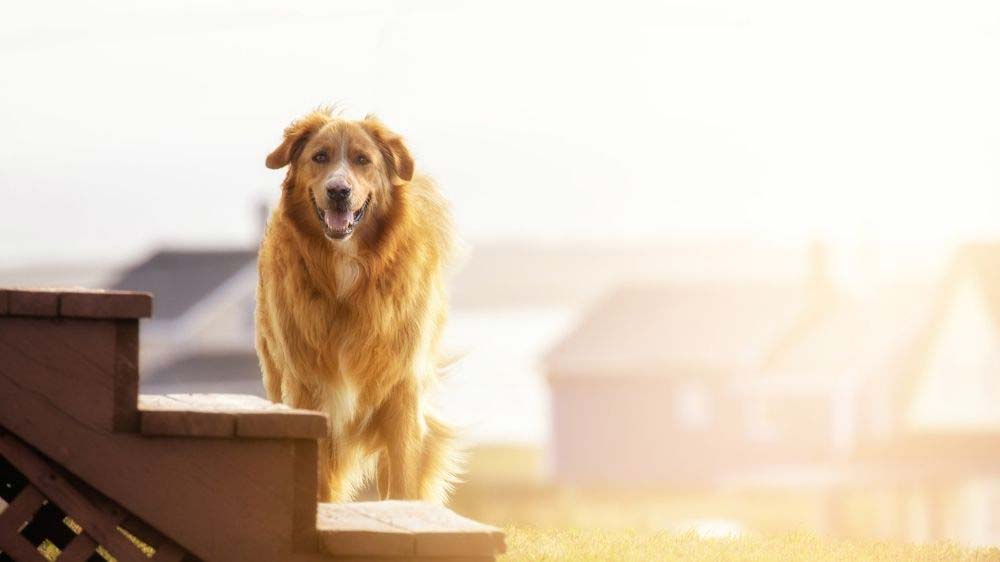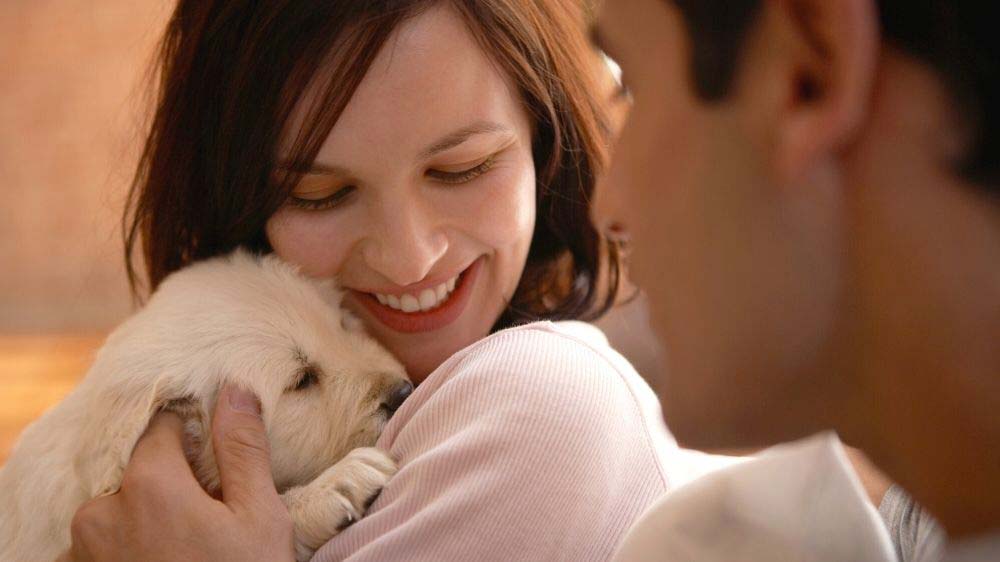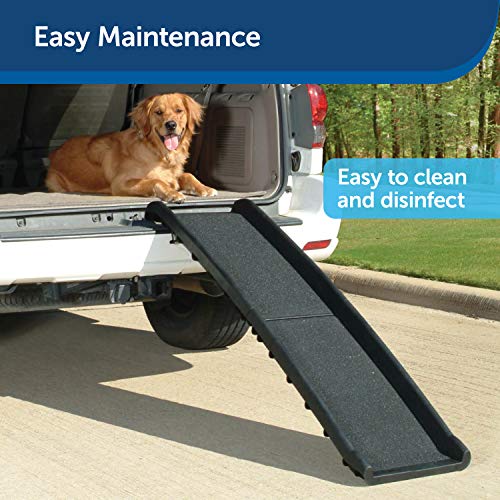Large dog breeds, like golden retrievers, are prone to hip and joint problems, such as hip dysplasia and arthritis. Using the stairs can often aggravate and worsen these conditions. But does this mean that golden retrievers must avoid all stairs?
In general, stairs are not bad for Golden Retrievers, provided they are young and healthy. Healthy adult golden retrievers can use the stairs but should do so slowly and safely. Young puppies, seniors, and golden retrievers with hip and joint issues, however, should avoid the stairs as much as possible.
In this article, you will learn more about why stairs can be problematic for golden retrievers and when your dog should not use the stairs. You will also learn some safety tips to help your golden retriever navigate or avoid stairs.

(This article may contain affiliate links and loyalgoldens may earn a commission if a purchase is made.)
Unlock your goldens natural intelligence and see just how quickly problem behaviors disappear.This is the best at home dog training I've ever used!
Why Stairs Can Be Bad for Golden Retrievers
The reason why stairs may be problematic for golden retrievers is that this breed is prone to joint issues, such as arthritis and canine hip dysplasia.
Arthritis is an inflammation of the joints due to damaged cartilage. As the cartilage changes and recedes, the bones in the joint rub together. This not only further damages the cartilage but is incredibly painful for your dog.
Hip dysplasia is a condition where the ball and socket of the hip joint do not grow together uniformly during puppyhood. This means that the ball and socket will not fit well together in adulthood. The hip joint cannot move fluidly as your dog walks. Instead, the two bones rub on one another, causing pain and limited mobility in your dog’s hips.
Going up and down the stairs daily can aggravate your golden’s joints and increase inflammation. While climbing stairs, your dog’s bones are rubbing together, only damaging the cartilage further and creating more pain.
However, the good news is that most adult golden retrievers should be able to use the stairs without problems. As your dog grows, you should monitor them for any signs of hip dysplasia, arthritis, or other hip and joint problems. As long as your dog is not showing any of these issues, they should have no problem using the stairs.
When Should Golden Retrievers Avoid the Stairs?
Though most golden retrievers can use the stairs without problems, there are a few situations where they should be avoided. Let’s take a closer look at these cases.
Golden Retriever Puppies and Stairs
Since the underlying cause of future hip dysplasia occurs when a golden retriever puppy is in their early growth phases, it’s important to make sure that there is not an undue amount of stress placed on the puppies joints early on. Therefore, it is crucial to make sure your puppy lives in an environment that encourages normal healthy joint formation. One way to do this is to prevent your puppy from using the stairs.
Using the stairs every day puts a lot of stress on your puppy’s hips and joints, causing inflammation, cartilage destruction, and possible injuries. Furthermore, puppies are often over-excited, clumsy, and still adjusting to their growing body, making them susceptible to falls and injuries while using the stairs.
When Can a Golden Retriever Puppy Climb Stairs?
Your golden retriever puppy should not be introduced to the stairs at all until they are at least twelve weeks old. However, experts advise keeping puppies of larger breeds, like golden retrievers off the stairs until they are sixteen weeks old, as an extra precaution.
Having said that, golden retriever puppies still continue growing substantially after the sixteen-week mark, meaning that their hips and joints are not even close to being fully formed. Because of this, experts advise carrying your golden retriever puppy up and down the stairs for the first year of their life or until they become too heavy. Doing this ensures that your puppy’s hips and joints grow properly without any injuries or problems.
Once your puppy is old enough to use the stairs, train them in basic stair safety. Supervise your golden retriever puppy until you feel confident they will use the stairs safely. Make sure they are walking up and down the stairs slowly and are not missing any steps. Training safe behavior on the stairs during puppyhood will prevent many injuries and joint problems in the future.
Recommended Reading: Can Golden Retriever Puppies Swim? (And Is It Safe?)
Golden Retriever Hip and Joint Issues = No Stairs
If your adult golden retriever is experiencing hip or joint issues, then it is crucial that they no longer use the stairs. Using the stairs will only worsen the conditions, leading to further pain and even more problems.
If your dog is experiencing these problems, they probably don’t want to use the stairs anyway. Look out for these symptoms in your golden to help diagnose any hip and joint issues:
- Difficulty walking
- Not wanting to go for walks
- Lack of energy
- Limping
- Difficulty standing for long periods
- Problems standing up from a laying position
In most cases, you will know if your golden is not feeling well and you’ll see a big change in their demeanor.
Arthritis, hip dysplasia, and other hip and joint problems can cause severe pain and limit their mobility, and you will likely see your older dog or senior golden retriever begin to avoid the stairs on their own. To ensure they live a comfortable life with minimal discomfort, you may need to rearrange their day-to-day lives so that they don’t need to use the stairs at all.
Safety Tips for Golden Retrievers Using the Stairs
Stairs cannot be avoided in many homes. Below are some tips to help your golden retriever use the stairs safely without developing hip and joint problems.
Supervise Your Golden on The Stairs
Supervising your golden retriever on the stairs is a great way to see if your dog struggles with stairs or is not using the stairs safely.
Dogs are infamous for hiding their health problems. Therefore, you may not know right away if your dog is struggling with any joint or hip conditions. However, it’s hard for a dog to hide their pain when using the stairs. When your golden retriever is near stairs, pay attention to any signs of fear or reluctance to use them.
Furthermore, if they are using the stairs slowly or awkwardly, then they may be in pain. If you see these signs, you should have your dog checked out at a vet for any hip and joint issues.
Supervision is also a great way to ensure your golden retriever puppy is using the stairs safely. Puppies are always full of excitement and energy, which means they don’t always think about safety. Make sure your puppy is not running up or down the stairs, skipping steps, or doing anything that will injure themselves or hurt the development of their hips.
Carry Your Golden Retriever Up & Down Stairs

Discover how to train your Golden Retriever by playing games: 21 games to play with your Golden that will make them smarter and better behaved!
As mentioned before, golden retriever puppies should be carried up and down the stairs for the first twelve months of their life or until they become too heavy. This option may seem like a hassle, but it is the best way to avoid any injuries or hip problems while your puppy is still growing.
Note: While good in theory, a 6-12 month old golden retriever is going to be too heavy to carry for many people, so just carry them on the stairs as long as you reasonably can. Injuring yourself to try to protect your golden retriever is not a good trade-off.
If your adult or senior golden retriever is having trouble on the stairs, you may need to carry them (if possible) on occasion. A senior dog with arthritis will be in too much pain to attempt the stairs, which means they might get stuck on a floor that they don’t want to be on. Do not force your dog to use the stairs in these cases, as that will only worsen their pain and condition. If this is happening, you will need to find a way to keep them off the stairs or reduce their pain.
Gates are very effective for this and not too expensive. Baby gates can be installed at the foot or head of any set of steps you need to keep your dog away from and should help to reduce their time spent struggling up and down the stairs.
Also, if your golden is used to sleeping, eating, etc. in a room upstairs, it’s probably time to move their bed, food, water, and toys downstairs so that there is no reason for them to go up the stairs at all.
Recommended Reading: Should I Let My Golden Retriever Sleep in Bed With Me (?)
Install a Dog Ramp For Your Golden Retriever
A dog ramp is a great way for your golden retriever to avoid the stairs. This option is best for adult golden retrievers that have developed arthritis, hip dysplasia, or other conditions. Ramps help dogs suffering from pain and limited mobility, as they are much better for your dog’s joints and prevent these conditions from worsening.
Furthermore, a dog ramp makes navigating the stairs easier and safer. You can install a dog ramp even if your dog is not experiencing any medical problems. Training your dog to use a dog ramp early on in life will help prevent hip and joint conditions from developing in the first place.
While a ramp might not work for a long flight of stairs, they can work great in areas where there are maybe a few steps to get in and out of the house, and/or to get them comfortably in and out of the car.
The PetSafe Happy Ride Folding Pet Ramp from Amazon will provide a safe and secure surface to walk up without any climbing, saving your goldens hip joints.
Use Stair Treads To Help Your Golden Navigate The Stairs
If you have bare wood stairs in your home, your golden retriever may have problems with slipping and sliding while climbing or descending the steps. This can cause falls and injuries, in addition to fostering a lack of confidence regarding stairs on your dogs part.
In this case, adding some non-slip stair treads can make a world of difference. These pre-cut Delxo Carpet Stair Treads (Amazon) have an adhesive backing and can be easily stuck to each step to provide traction for your golden retriever.
Give Your Golden a Joint Supplement
Many dog owners begin giving their golden retrievers joint supplements when they start displaying hip and joint discomfort, but a much better idea is to start giving your pup these supplements long before they experience pain.
Giving your golden retriever a good joint supplement, such as Cosequin Max Strength Plus MSM from Amazon, containing Glucosamine and Chondroitin early on will be a much greater help than waiting until your golden is older and experiencing pain.
It’s actually recommended by dvm360 to start giving large breed dogs like golden retrievers these types of supplements as early as possible. Golden retriever puppies can begin using these hip and joint supplements as early as 8 weeks of age, although you will want to consult with your vet regarding your specific puppy before starting any supplements.
Final Thoughts
In most cases, a healthy golden retriever can use the stairs without any problems. However, due to a golden retrievers’ disposition to hip and joint problems, you will want to ensure they use the stairs safely. Puppies and golden retrievers with hip and joint problems should either use a dog ramp or avoid the stairs altogether.
Recommended Reading: How Long Does It Take To Crate Train a Golden Retriever Puppy?


